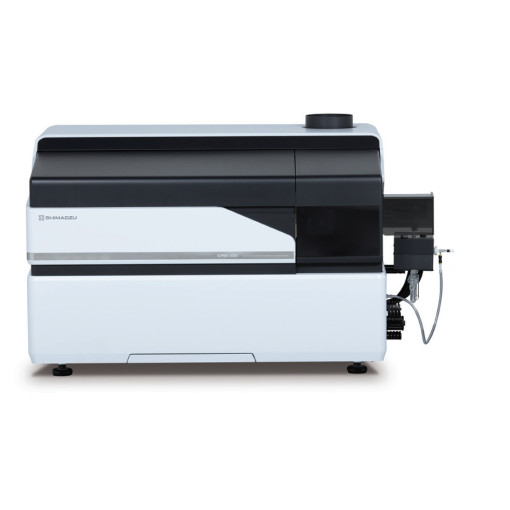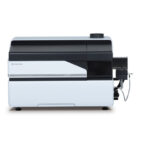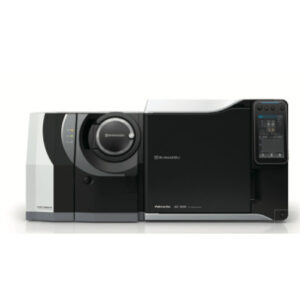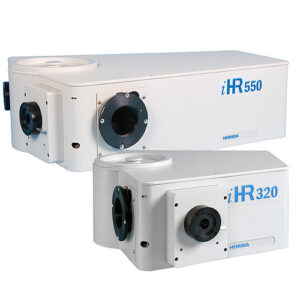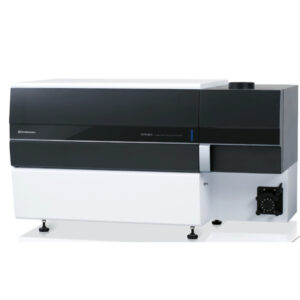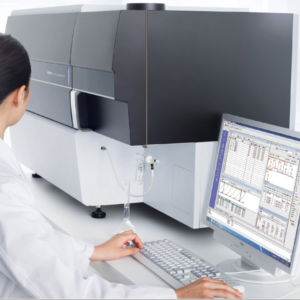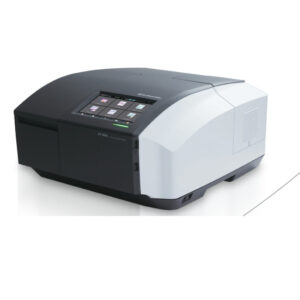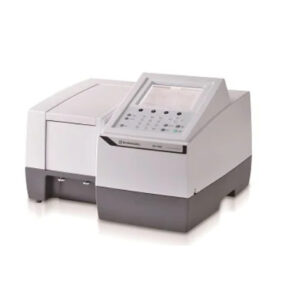ICPMS-2030 LF Inductively Coupled Plasma Mass Spectrometer
The ICPMS-2030 LF is quantitative and qualitative mass analyzer having an inductively coupled plasma ion source. This instrument is a very convenient for element analysis of solution sample and superior to ICP emission spectrometers, in detecting sensitivity.
- Description
- Additional information
Description
HIGHLIGHTS
With its newly developed collision cell and optimized internal structure, the ICPMS-2030 provides superior sensitivity. At the same time, thanks to the adoption of its proprietary mini-torch unit and provision of an Eco mode, the quantity of argon gas needed for analyses has been greatly reduced to the industry’s lowest levels. As a result, low running costs are assured. The Development Assistant function of the software automatically sets the optimal analysis conditions for quantitative analysis. Then, after measurements are complete, the Diagnosis Assistant function automatically checks the validity of the necessary data. While reducing the burden on the user, the efficiency of analyses is enhanced and the reliability of the data can be increased. It complies with FDA 21 CFR Part 11
Accelerating Reliable Performance
The first system in the industry to include functions for assisting with analytical method development and diagnostics.
Newly developed collision cell and On-Line IEC work together to eliminate spectral interference, and achieve high-sensitive and low-interference analyses.
Unique system developed by Shimadzu results in the industry’s lowest running costs.
| Plasma Ion Source Unit | |
| Spray chamber | Cyclone chamber (Thermoelectric cooling type: -10 °C to 10 °C) |
| Peristaltic pump | 4-channel, 12 roller pump |
| Plasma torch | Quarts-made mini torch |
| Nebulizer | High Efficiency Concentric (coaxial) nebulizer Made of borosilicate glass |
| Torch position adjustment | X,Y,Z-axes automatic adjustment Horizontal and vertical position range: ±2 mm (0.1 mm step) Sampling depth:2 to 12 mm |
| Plasma View | Easy-View window for visual monitoring of plasma to check torch, RF coil |
| Gas control | Gas flowrate is auto controlled from CPU Flowrate setting range Plasma gas (Ar) 7 to 20 L/min Auxiliary gas (Ar) 0.3 to 1.5 L/min Carrier gas (Ar) 0.3 to 1.5 L/min |
| Economy running mode (Mini-Torch) | Plasma gas (Ar) 5 L/min Auxiliary gas (Ar) 0.6 L/min |
| RF Power Supply Unit | |
| Transmitter | Free running |
| Frequency | 27 MHz |
| RF Power | 0.5 kW (Eco mode) and 0.8 kW to 1.4 kW (1.2 kW when using mini torch) |
| Output stability | Within ±0.3 % |
| Radio-frequency circuit element | All solid state |
| Ignition method | Full automatic ignition |
| Load matching function | Automatic matching |
| Energy saving function | Economic running mode |
| Interface | |
| Sampling cone | Cu sampling cone 1.1 mm diameter orifice (Option: Ni, Pt) |
| Skimmer cone | Cu skimmer cone 0.35 mm diameter orifice (Option: Ni, Pt) |
| Removable interface to device | No tool required Interface system designed with easy access for maintenance |
| Ion Lens | Advanced Off-axis lens after Cell Delivers high ion transfer efficiency |
| Collision cell | |
| Type | Octopole collision cell |
| Gas controller | Gas flowrate is auto controlled from CPU (Used gas: Helium gas) – Flowrate setting range: 0 to 10 mL/min |
| Mass Spectrometer Unit | |
| Mass analyzer | Quadruple type mass spectrometer Molybdenum-made hyperbolic rod (Main rod) Molybdenum-made cylindrical rod (Pre-rod) |
| Power supply frequency | 2.5 MHz |
| Mass range | 5 to 260 amu |
| Resolution | 0.5 u to 1.0 u (at 5 to 225 amu) * |
| Mass Accuracy | ±0.1 u (209Bi) |
| Mass Stability | 0.03 u / 24 Hr (115In) |
| Abundance sensitivity (at 133Cs) | Low mass side ≦5×10-7 High mass side ≦1×10-7 |
| Detector | |
| Detector | Dual-mode electron multiplier |
| Dynamic range | 9 order (1 cps to 109 cps) |
| Minimum dwell time | 1 msec |
| Exhaust system | 3-stage operation exhaust First stage Rotary pump 2nd stage, 3rd stage Air-cooling type turbo molecular pump |
| Performance Specifications | |
| Sensitivity (Mcps/ppm) | |
| 9Be | > 6 |
| 115In | >125 |
| 209Bi | >100 |
| Detection Limit (ppt) | |
| 9Be | <0.5 |
| 115ln | <0.1 |
| 209Bi | <0.1 |
| Background (CPS) | |
| m/Z 220 | <1 |
| Oxide ratio (%) | |
| CeO/Ce | <2 |
| Doubly Charge(%) | |
| Ce++/Ce | <3 |
| Stability %RSD | |
| Short Term | < 3% (20 min) |
| Long Term | < 4% (4 Hr) |
| He Cell Mode | |
| Co (Mcps/ppm) | > 6 |
| Dimensions | W 870 x D 645 x H 587 mm (excluding protrusion) |
| Weight | |
| Main body | 140 kg |
| Rotary Pump | 50 kg |
| Temperature | 18 °C to 28 °C (max. 2 °C/h temperature change) |
| Humidity | 20 to 70% RH (No condensation) |
| Other | Avoid using the system in locations with significant vibration or dust |
| Power Supply | |
| Main Unit | Single-phase 200 to 240 V ± 10 %, 50/60 Hz, 6 kVA |
| Data Processing | Single-phase 100 to 240V ± 10 %, 50/60 Hz, 200 VA |
| Cooling Water Circulator (Option) | Single-phase 200 to 230 V, 50/60 Hz, 2 kVA |
| Grounding | Use the single earth of the ground resistance 30 Ω max |
| Gas Supply | |
| Argon gas | 99.95 % or more purity, Pressure 450±10 kPa |
| Helium gas | 99.999 % or more purity, Pressure 150±20 kPa |
| Cooling Water | |
| Pressure | 150 to 300 kPa |
| Temperature | 5 to 30 °C |
| Exhaust Duct | Adjusting to the displacement of 1.4 to 2 m3/min is possible at the outlet of the main body exhaust cylinder |
| Environmental, Drinking Water, and Wastewater Analysis |
| Food Products/Agriculture |
| Pharmaceuticals/Pharmacopoeia |
| AS-10 Autosampler | |
| Vials: | 60 15-mL vials 8 50-mL vials |
| Size | W290 × D508 × H300 mm (excluding arm) |
| Power supply | Single-phase 100–240 V, 50/60 Hz, 50 VA |
| ASX-560 Autosampler | |
| Vials: | 10 50-mL vials (standard samples) or 240 14-mL vials 160 20-mL vials (rack sold separately) 84 50-mL vials (rack sold separately) |
| Size | W580 × D550 × H620 mm (include sample probe) W90 × D180 × H60 mm (rough dimensions of power supply unit) |
| Power supply | 100-240 V AC, 47-63 Hz, 1.9 A |
| ASX-280 Autosampler | |
| Vials: | 10 50-mL vials (standard samples) or 120 14-mL vials 80 20-mL vials (rack sold separately) 42 50-mL vials (rack sold separately) |
| Size | W355 × D550 × H620 mm (include sample probe) W90 × D180 × H60 mm (rough dimensions of power supply unit) |
| Power supply | 100-240 V AC, 47-63 Hz, 1.9A |
| Cooling Water Circulator | |
| Size | W377 × D500 × H615 mm |
| Power supply | AC 200 V–230 V, 50/60 Hz, 2 kVA |
| Weight | 43 kg |
| Automatic Internal Standard Addition Kit | This kit is used for in-line mixing of measurement sample and internal standard solutions and introducing the mixtures into the ICP system. |
| Tap Water Connection Kit | This is required if using tap water to cool the main ICPMS-2030 unit. |
| Noise Absorbing Box, SV65 Large | |
| Exhaust Duct Connection Adapter | Needed when connecting a flexible duct made of stainless steel having an internal diameter of 100 mm to the exhaust duct of the plasma stand. |
| HFS-5 Hydrofluoric Acid Sample Injection System | This system includes a torch, chamber, extension tube, nebulizer, drain, and their corresponding accessory parts. Used to directly inject samples that contain hydrofluoric acid. The nebulizer, chamber, and drain system are made using fluoropolymer materials and the injector unit on the torch is made using alumina. |
| Organic Solvent Injection System | To introduce organic solvents, a mixture of argon and oxygen gases (70% Ar and 30% O2 ) is injected into the interface unit to prevent precipitation of carbon (C) by the organic solvent. This system includes a Quadruple Torch for Organic Solvents, ICPMS, drain, and their corresponding accessory parts. |
| LC–ICP–MS System | It can be used as the LC–ICP–MS system by connecting the ICPMS-2030 and the Prominence™ inert LC system online |
| LA–ICP–MS System (Laser Ablation ICP–MS System) | The LA–ICP–MS system can be set by combining the ICPMS-2030 and other companies’ laser ablation equipment. |
| Measurement sample | |
| 1 data file | Maximum 300 samples |
| Pasting of sample information | It is possible to paste the sample information to the sample table from the clip board |
| Qualitative analysis | |
| Method of analysis | Analysis using the built-in data base |
| Selecting Mass number | Select the optimum mass in auto every measurement sample |
| Correction | The data base calibration function is available |
| Quantitative analysis | |
| Measured mass | It is possible to set the multiple measured mass every elements. Total mass profile measurement |
| Correction method | Internal standard correction, inter-element correction, interference correction, drift correction, dilute correction |
| Calibration curve | First to secondary equation Quantitative lower limit display |
| Printing | Setting for the printing items Automatic printing when measuring (Analysis results) Batch printing (Analysis conditions/ calibration curves/ analysis results, etc.) |
| Copy of the display window | Use a clip board function of the Windows, and copying is possible to other applications such a |
| Export of the data | It is possible to output the analyzed results to the files in a CSV format or a tab delimited text format. Automatic export when measuring Batch export |
| Re-calculation function | Changes of the calibration curve conditions such as the calibration curve order Re-calculation by changing the corrective conditions. Add and re-calculate the analysis element/mass using the total mass profile. |
| Assistant function | |
| Development assistant | Based on the qualitative analysis data (for all mass numbers) from a representative sample, the Development Assistant automatically selects the optimal mass numbers and internal standard elements for the target measurement elements and automatically specifies the concentration range for calibration curve samples. |
| Diagnosis assistant | The Diagnosis Assistant automatically diagnoses spectral interference, based on data measured from all mass numbers. Even when using an already established method for routine analysis, the software analyzes data for any spectral interference to determine if a problem occurred. |
| Instrument control | |
| QA/QC functions | Assessment of a calibration curve and re-calibration Fluctuation evaluation of the internal standard elements Assessment of a drift during measuring and re-calibration / re -measurement Addition/collection tests Dilution test Re-measurement test |
| Instrument control | Monitor display for instrument status Control vacuum pump Plasma on/off Automatic plasma off after analysis Auto sampler (option) control Economy running mode |
Additional information
| Manufacturer | Shimadzu |
|---|---|
| Origin | Japan |
| Type | Automatic |

